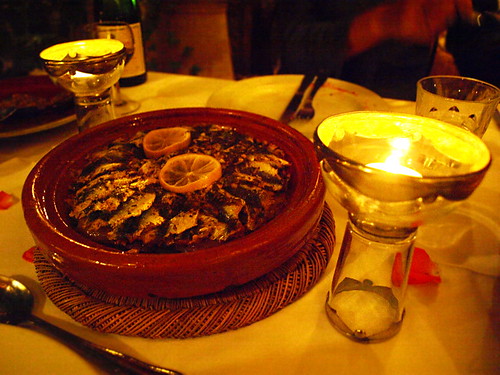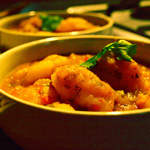Exploring a country’s culinary offerings is always one of the aspects of travel that gets our…well, juices flowing, so to speak. As Moroccan cuisine is often described as being a diverse mix of Berber, Arab and even Mediterranean influences with much use of the exotic spices, we were excited by the prospect of venturing into the world of the Medina and souks of Marrakech to treat our senses to the culinary goodies on offer.
However, one of the first things that occurred to us as on our first investigation into what delicacies were to be found on the menus around the Medina and in Jemaa El Fna square was that, generally speaking, they are all very, very similar. Most restaurants serving traditional Moroccan food have menus which include Moroccan salads, kebabs, keftas, couscous, tajines and occasionally pastillas (chicken, meat or seafood wrapped in puff pastry).
Even some of the more stylish, contemporary restaurants seemed to feature mostly the same menu; the main difference being in the price with main courses ranging from 30DH in basic restaurants to 150-200DH in more upmarket establishments. There are plenty of places in Marrakech, especially in Guéliz and Hivernage in the new town, where visitors can find a wider variety of culinary choice (see our Marrakech ‘insider’s’ guide) but on our visit we were particularly interested in sampling Moroccan fare.
Jemaa el Fna
Stay in Marrakech and you have to eat in Jemaa el Fna square at least once. There’s a hypnotic madness to the place and it’s fascinating to watch the stalls take shape early evening as the square is transformed into a maelstrom of sights, sounds and smells with smoke billowing from stalls which are a mirror image of each other. The language used to attract diners can be bizarrely of the Only Fools and Horses variety – Del Boy Does Marrakech – and although stall No1 seems to be the most recommended, there seems to be little difference between them all. As well as being an essential Marrakech experience, they also offer more of a variety than found in many of the menus in restaurants surrounding the square with fish and seafood dishes an option. They say you can have sheep’s heads here but I didn’t spot any, however, if you want to go for the adventurous option you could try pigeon pie (which I would have chosen but didn’t know about until too late) or grab a stool at one of the speciality snail stalls. Food at Jemaa el Fna is good value with main courses costing around 30DH.

Chez Abdelkabir (Jemaa el Fna)
Recommended by our riad’s house manager, Chez Abdelkabir sits at the top end of the square. It’s basic; a few benches and tables with napkins which look like squares of ordinary paper. We were the only foreigners in the restaurant. The menu is much as described above and we ordered a plate of meat (possibly lamb) kebabs and a plate of meat chops (possibly camel? – it’s pale but for obvious reasons definitely not pork). They were served with chopped onion and olives and the obligatory round of Moroccan bread. The meat was tasty, lightly spiced and tender if slightly fatty. Each dish is 22DH. It’s a good, cheap little place to eat. For something different try a tangia (a traditional single man’s dish) or some tripe.
Chez Chagrouni (Jemaa el Fna)
Chez Chegrouni gets good ratings on TripAdvisor and is an attractive looking, Moroccan styled restaurant overlooking Jemaa el Fna. Seats in the lower terrace face outwards as though watching a show, which in many ways you are. We tried the chicken & vegetable couscous and meat keftas. The couscous was quite dry and not as spiced as we would have expected whilst the keftas were nicely meaty. It was okay but didn’t match some of the reviews we read. Meals were around 40DH each. An unusual touch is that you write out your own order on a slip. Strange but seems to work well.
Chez Karim (No15, La Place des Ferblantiers)
The tajines are cooked on mini clay stoves on the street which is what enticed us in. Chez Karim is one of a few tiny street restaurants crammed in a corner of La Place des Ferblantiers beside the Badi Palace. We shared a table with a Spanish group who all ordered burgers whilst we ordered lamb and chicken tajines. What I like about this place is the waiter will show you the tajine as it’s cooking so you know what you get. Ours included peppers, tomatoes, olives, orange, meat and spices whose flavours had fused under a wall of sliced potatoes. They were very, very filling. Great value at 30DH each.

Café Bougainvillea (End of Rue Mouassine)
After a couple of days of couscous, tajines and kebabs, it can be nice to have a culinary change of scene and there are some restaurants in the Medina in Marrakech where it’s possible to take a break from traditional Moroccan cuisine and also the frenetic pace at Jemaa el Fna square. Café Bougainvillea is an oasis of calm whose décor is a mix of artistically chic retro styles and typical Moroccan (huge metal ball lights with intrinsic designs). The food is Italian/Moroccan/French and the atmosphere relaxed and friendly. We opted for a margarita and a ‘house’ pizza. The pizza base was interesting, like a thin crust pizza version of the khubz bread you’re served up in every restaurant in Marrakech. I liked it. The margarita got the thumbs up, but the house pizza although inoffensive was a bit bland. Prices for main courses range from 45-60DH.

Eating in the Riad
Some people claim that restaurants and food stalls in Marrakech exist mainly for tourists and for grabbing a quick snack and that the best cooking has evolved in the home. Our experiences backed this claim up. The meal created by Rashida, the cook at Riad Merstane was inventively diverse and delicious and featured a dish that we never saw on the menu of any restaurant in Marrakech, sardine tajine. The meal could have fed an army and I don’t believe we ever actually felt hungry again for the rest of our travels in Morocco.
If we were being totally honest, the food in the restaurants although good, didn’t live up to the claims we read previously that Moroccan food was considered to be amongst the best in the world.
On the other hand, the meals we ate that was prepared in the riad and also by our Berber guides in the Atlas Mountains were of a completely different calibre. They were clearly created with the utmost care and attention to detail and their flavours reflected this.
If you only dine twice in Marrakech once should be at Jemaa el Fna, the other should be a ‘home’ prepared meal.







Be the first to comment